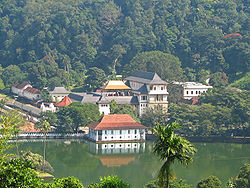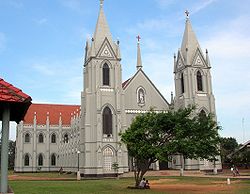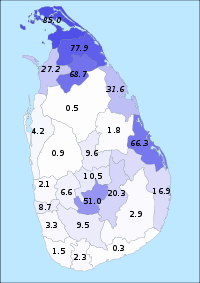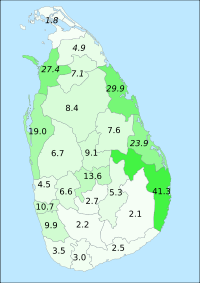
Religion in Sri Lanka
Encyclopedia
Sri Lanka
's population practices a variety of religion
s. 70% of Sri Lankans are Theravada Buddhists, 15% are Hindu
s, 7.5% are Muslim
s and 7.5% Christian
s. Sri Lanka was ranked the 3rd most religious country in the world by a 2008 Gallup poll, with 99% of Sri Lankans saying religion is an important part of their daily life.
 Theravada Buddhism is the major religion in Sri Lanka, with about 70% of the country's population as followers. Arahath Mahinda
Theravada Buddhism is the major religion in Sri Lanka, with about 70% of the country's population as followers. Arahath Mahinda
son of Indian Buddhist emperor Ashoka
, led the mission to Sri Lanka in 246 BC where he converted the Sri Lankan king of that time Devanampiya Tissa to Buddhism. Arahath Sanghamitra, daughter of King Ashoka, brought a sapling of the Bodhi tree
in Buddha Gaya to Sri Lanka. She also established the Order of Nuns in Sri Lanka. The Sapling of the Bodhi tree, known as Jaya Sri Maha Bodhi was planted in the Mahameghavana Park in Anuradhapura
by the King Devanampiya Tissa.
From then on, the royal families had helped to encourage the spread of Buddhism, aiding Buddhist missionaries and building monasteries. Around 200 BC, Buddhism became the official religion of Sri Lanka. The Sacred Tooth Relic
was brought to Sri Lanka in 4th century AD by Prince Danta and Princess Hemamala. Sri Lanka has the longest continuous history of Buddhism of any Buddhist nation. During the periods of decline, the Sri Lankan monastic lineage was revived through contacts with Myanmar
and Thailand
. However, later on, Hindu and European colonial influences contributed to the decline of Buddhism in Sri Lanka. By the mid 19th century, Buddhist leaders such as Migettuwatte Gunananda Thera
, Colonel Henry Steel Olcott
and Anagarika Dharmapala
started a successful national Buddhist movement for the revival of Buddhism in Sri Lanka.
 Hindus
Hindus
make up 16% of Sri Lanka's population. Hinduism was the major religion practiced on the island prior to the introduction of Buddhism in the 3rd century BC and the subsequent adoption of the new religion by the Sinhalese population. Nonetheless, Hinduism survived and endured in Sri Lanka, supported by South Indian and Orissan dynasties that conquered parts of the island through history.
As with other religions, it experienced some decline during the European colonization of the country as a result of the heavy emphasis on Christianity. In modern times the religion is still dominant in the Northern and Eastern provinces, among the Tamil
ethnic group, though modern day conversions to Christianity still represent some decline.
With 16% of the total population Hinduism is a minority religion in Sri Lanka, though it continues to flourish among the Sri Lankan Tamil diaspora
; with many temples and religious establishments being built by this community in their new homelands.
The most important Hindu religious figure in Sri Lankan modern history is, inarguably, Satguru Siva Yogaswami
of Jaffna
. One of the greatest and most profound mystics of the twentieth century, Yogaswami was the official satguru
and counseling sage of Lanka's several million Tamil Hindu population.
 By the 15th century, Arab
By the 15th century, Arab
traders had controlled much of the trade on the Indian Ocean
, including that of Sri Lanka's. Many of these traders settled down in Sri Lanka, encouraging the spread of Islam
. However, when the Portuguese arrived at Sri Lanka during the 16th century, many of their Muslim descendants were persecuted, thus forcing them to migrate to the Central Highlands and to the east coast.
In modern times, Muslims in Sri Lanka are handled by the Muslim Religious and Cultural Affairs Department, which was established in the 1980s to prevent the continual isolation of the Muslim community from the rest of Sri Lanka. Today, about 8% of Sri Lankans adhere to Islam; mostly from the Arab-descendant Moor
and Malay
ethnic communities on the island.
 According to Christian
According to Christian
traditions, Thomas the Apostle first arrived in Sri Lanka (as well as India
) during the 1st century. After his arrival, small Christian settlements were recorded to have been established on Sri Lanka's coastline. However, the population of Christians in Sri Lanka didn't dramatically increase until the arrival of Portuguese
missionaries during the 15th century. In the 17th century, the Dutch
took over Sri Lanka and Dutch missionaries were able to convert 21% of Sri Lanka's population to Christianity by 1722.
In 1796 the Dutch were displaced by the British and in 1802 Ceylon became a Crown colony. Anglican and other Protestant missionaries arrived at Sri Lanka during the early 19th century, when the British took control of Sri Lanka from the Dutch. Under British rule missionary work was undertaken by English societies: Baptist, Wesleyan Methodist, the CMS and SPG. The Salvation Army
is also strong in Sri Lanka.
Even so, Christianity has heavily declined in Sri Lanka ever since the end of colonial rule. By the 1980s, the population of Christians (mostly concentrated in the northwest of Sri Lanka) reached 1,283,600, 8% of Sri Lanka's population. Of these Christians, about 88% are Roman Catholic
s and the rest are Anglican and Protestant.
Sri Lanka
Sri Lanka, officially the Democratic Socialist Republic of Sri Lanka is a country off the southern coast of the Indian subcontinent. Known until 1972 as Ceylon , Sri Lanka is an island surrounded by the Indian Ocean, the Gulf of Mannar and the Palk Strait, and lies in the vicinity of India and the...
's population practices a variety of religion
Religion
Religion is a collection of cultural systems, belief systems, and worldviews that establishes symbols that relate humanity to spirituality and, sometimes, to moral values. Many religions have narratives, symbols, traditions and sacred histories that are intended to give meaning to life or to...
s. 70% of Sri Lankans are Theravada Buddhists, 15% are Hindu
Hindu
Hindu refers to an identity associated with the philosophical, religious and cultural systems that are indigenous to the Indian subcontinent. As used in the Constitution of India, the word "Hindu" is also attributed to all persons professing any Indian religion...
s, 7.5% are Muslim
Muslim
A Muslim, also spelled Moslem, is an adherent of Islam, a monotheistic, Abrahamic religion based on the Quran, which Muslims consider the verbatim word of God as revealed to prophet Muhammad. "Muslim" is the Arabic term for "submitter" .Muslims believe that God is one and incomparable...
s and 7.5% Christian
Christian
A Christian is a person who adheres to Christianity, an Abrahamic, monotheistic religion based on the life and teachings of Jesus of Nazareth as recorded in the Canonical gospels and the letters of the New Testament...
s. Sri Lanka was ranked the 3rd most religious country in the world by a 2008 Gallup poll, with 99% of Sri Lankans saying religion is an important part of their daily life.
| Buddhism [70%] | Hinduism [15%] | Christianity [7.5%] | Islam [7.5%] |
|---|---|---|---|
 |
 |
 |
 |
| Distribution of the four major denominations in Sri Lanka. The percentages shown are from 2001 census except where the numbers are italic, which are from 1981 census. Population movements have occurred after 1981, and accurate statistics do not exist for these districts. | |||
Buddhism

Mahinda
Mahinda was a Buddhist monk depicted in Buddhist sources as bringing Buddhism to Sri Lanka. He was the son of the Mauryan Emperor Ashoka.- Historical Sources :...
son of Indian Buddhist emperor Ashoka
Ashoka
Ashok Maurya or Ashoka , popularly known as Ashoka the Great, was an Indian emperor of the Maurya Dynasty who ruled almost all of the Indian subcontinent from ca. 269 BC to 232 BC. One of India's greatest emperors, Ashoka reigned over most of present-day India after a number of military conquests...
, led the mission to Sri Lanka in 246 BC where he converted the Sri Lankan king of that time Devanampiya Tissa to Buddhism. Arahath Sanghamitra, daughter of King Ashoka, brought a sapling of the Bodhi tree
Bodhi tree
The Bodhi Tree, also known as Bo , was a large and very old Sacred Fig tree located in Bodh Gaya , under which Siddhartha Gautama, the spiritual teacher and founder of Buddhism later known as Gautama Buddha, is said to have achieved enlightenment, or Bodhi...
in Buddha Gaya to Sri Lanka. She also established the Order of Nuns in Sri Lanka. The Sapling of the Bodhi tree, known as Jaya Sri Maha Bodhi was planted in the Mahameghavana Park in Anuradhapura
Anuradhapura
Anuradhapura, , is one of the ancient capitals of Sri Lanka, famous for its well-preserved ruins of ancient Lankan civilization.The city, now a UNESCO World Heritage Site, lies 205 km north of the current capital Colombo in Sri Lanka's North Central Province, on the banks of the historic...
by the King Devanampiya Tissa.
From then on, the royal families had helped to encourage the spread of Buddhism, aiding Buddhist missionaries and building monasteries. Around 200 BC, Buddhism became the official religion of Sri Lanka. The Sacred Tooth Relic
Relic of the tooth of the Buddha
The Sacred Relic of the tooth of Buddha is venerated in Sri Lanka as a relic of the founder of Buddhism.-The relic in India:...
was brought to Sri Lanka in 4th century AD by Prince Danta and Princess Hemamala. Sri Lanka has the longest continuous history of Buddhism of any Buddhist nation. During the periods of decline, the Sri Lankan monastic lineage was revived through contacts with Myanmar
Myanmar
Burma , officially the Republic of the Union of Myanmar , is a country in Southeast Asia. Burma is bordered by China on the northeast, Laos on the east, Thailand on the southeast, Bangladesh on the west, India on the northwest, the Bay of Bengal to the southwest, and the Andaman Sea on the south....
and Thailand
Thailand
Thailand , officially the Kingdom of Thailand , formerly known as Siam , is a country located at the centre of the Indochina peninsula and Southeast Asia. It is bordered to the north by Burma and Laos, to the east by Laos and Cambodia, to the south by the Gulf of Thailand and Malaysia, and to the...
. However, later on, Hindu and European colonial influences contributed to the decline of Buddhism in Sri Lanka. By the mid 19th century, Buddhist leaders such as Migettuwatte Gunananda Thera
Migettuwatte Gunananda Thera
Migettuwatte Gunananda Thera or Mohottiwatte Gunananda Thera was a Sri Lankan Buddhist orator. He is known for leading the Buddhist side in debates that occurred between the Buddhists and the Christians in Baddegama, Udanwita, Waragoda, Liyanagemulla, Gampola, and in the most famous of the debates...
, Colonel Henry Steel Olcott
Henry Steel Olcott
Colonel Henry Steel Olcott was an American military officer, journalist, lawyer and the co-founder and first President of the Theosophical Society....
and Anagarika Dharmapala
Anagarika Dharmapala
Anagarika Dharmapala was a leading figure of Buddhism in the twentieth century. He was one of the founding contributors of Sinhalese Buddhist Nationalism and Protestant Buddhism...
started a successful national Buddhist movement for the revival of Buddhism in Sri Lanka.
Hinduism

Hinduism
Hinduism is the predominant and indigenous religious tradition of the Indian Subcontinent. Hinduism is known to its followers as , amongst many other expressions...
make up 16% of Sri Lanka's population. Hinduism was the major religion practiced on the island prior to the introduction of Buddhism in the 3rd century BC and the subsequent adoption of the new religion by the Sinhalese population. Nonetheless, Hinduism survived and endured in Sri Lanka, supported by South Indian and Orissan dynasties that conquered parts of the island through history.
As with other religions, it experienced some decline during the European colonization of the country as a result of the heavy emphasis on Christianity. In modern times the religion is still dominant in the Northern and Eastern provinces, among the Tamil
Tamil people
Tamil people , also called Tamils or Tamilians, are an ethnic group native to Tamil Nadu, India and the north-eastern region of Sri Lanka. Historic and post 15th century emigrant communities are also found across the world, notably Malaysia, Singapore, Mauritius, South Africa, Australia, Canada,...
ethnic group, though modern day conversions to Christianity still represent some decline.
With 16% of the total population Hinduism is a minority religion in Sri Lanka, though it continues to flourish among the Sri Lankan Tamil diaspora
Sri Lankan Tamil diaspora
The Sri Lankan Tamil Diaspora refers to the global diaspora of the people of Sri Lankan Tamil origin. It can be said to be a subset of the larger Sri Lankan as well as Tamil diaspora....
; with many temples and religious establishments being built by this community in their new homelands.
The most important Hindu religious figure in Sri Lankan modern history is, inarguably, Satguru Siva Yogaswami
Yogaswami
Jnanaguru Siva Yogaswami of Jaffna was Sri Lanka's most renowned 20th-century spiritual master, a Śivajnani and a natha siddhar revered by both Hindus and Buddhists...
of Jaffna
Jaffna
Jaffna is the capital city of the Northern Province, Sri Lanka. It is the administrative headquarters of the Jaffna district located on a peninsula of the same name. Jaffna is approximately six miles away from Kandarodai which served as a famous emporium in the Jaffna peninsula from classical...
. One of the greatest and most profound mystics of the twentieth century, Yogaswami was the official satguru
Satguru
Satguru does not merely mean true guru. The term is distinguished from other forms of gurus, such as musical instructors, scriptural teachers, parents, and so on...
and counseling sage of Lanka's several million Tamil Hindu population.
Islam

Arab
Arab people, also known as Arabs , are a panethnicity primarily living in the Arab world, which is located in Western Asia and North Africa. They are identified as such on one or more of genealogical, linguistic, or cultural grounds, with tribal affiliations, and intra-tribal relationships playing...
traders had controlled much of the trade on the Indian Ocean
Indian Ocean
The Indian Ocean is the third largest of the world's oceanic divisions, covering approximately 20% of the water on the Earth's surface. It is bounded on the north by the Indian Subcontinent and Arabian Peninsula ; on the west by eastern Africa; on the east by Indochina, the Sunda Islands, and...
, including that of Sri Lanka's. Many of these traders settled down in Sri Lanka, encouraging the spread of Islam
Islam
Islam . The most common are and . : Arabic pronunciation varies regionally. The first vowel ranges from ~~. The second vowel ranges from ~~~...
. However, when the Portuguese arrived at Sri Lanka during the 16th century, many of their Muslim descendants were persecuted, thus forcing them to migrate to the Central Highlands and to the east coast.
In modern times, Muslims in Sri Lanka are handled by the Muslim Religious and Cultural Affairs Department, which was established in the 1980s to prevent the continual isolation of the Muslim community from the rest of Sri Lanka. Today, about 8% of Sri Lankans adhere to Islam; mostly from the Arab-descendant Moor
Sri Lankan Moors
The Sri Lankan Moors are the third largest ethnic group in Sri Lanka comprising 8% of the country's total population . They are predominantly followers of Islam. The Moors trace their ancestry to Arab traders who settled in Sri Lanka some time between the 8th and 15th centuries...
and Malay
Sri Lankan Malays
The Malays of Sri Lanka originated in Southeast Asia and today consist of about 50,000 people...
ethnic communities on the island.
Christianity

Christianity
Christianity is a monotheistic religion based on the life and teachings of Jesus as presented in canonical gospels and other New Testament writings...
traditions, Thomas the Apostle first arrived in Sri Lanka (as well as India
India
India , officially the Republic of India , is a country in South Asia. It is the seventh-largest country by geographical area, the second-most populous country with over 1.2 billion people, and the most populous democracy in the world...
) during the 1st century. After his arrival, small Christian settlements were recorded to have been established on Sri Lanka's coastline. However, the population of Christians in Sri Lanka didn't dramatically increase until the arrival of Portuguese
Portuguese people
The Portuguese are a nation and ethnic group native to the country of Portugal, in the west of the Iberian peninsula of south-west Europe. Their language is Portuguese, and Roman Catholicism is the predominant religion....
missionaries during the 15th century. In the 17th century, the Dutch
Netherlands
The Netherlands is a constituent country of the Kingdom of the Netherlands, located mainly in North-West Europe and with several islands in the Caribbean. Mainland Netherlands borders the North Sea to the north and west, Belgium to the south, and Germany to the east, and shares maritime borders...
took over Sri Lanka and Dutch missionaries were able to convert 21% of Sri Lanka's population to Christianity by 1722.
In 1796 the Dutch were displaced by the British and in 1802 Ceylon became a Crown colony. Anglican and other Protestant missionaries arrived at Sri Lanka during the early 19th century, when the British took control of Sri Lanka from the Dutch. Under British rule missionary work was undertaken by English societies: Baptist, Wesleyan Methodist, the CMS and SPG. The Salvation Army
Salvation Army
The Salvation Army is a Protestant Christian church known for its thrift stores and charity work. It is an international movement that currently works in over a hundred countries....
is also strong in Sri Lanka.
Even so, Christianity has heavily declined in Sri Lanka ever since the end of colonial rule. By the 1980s, the population of Christians (mostly concentrated in the northwest of Sri Lanka) reached 1,283,600, 8% of Sri Lanka's population. Of these Christians, about 88% are Roman Catholic
Roman Catholic Church
The Catholic Church, also known as the Roman Catholic Church, is the world's largest Christian church, with over a billion members. Led by the Pope, it defines its mission as spreading the gospel of Jesus Christ, administering the sacraments and exercising charity...
s and the rest are Anglican and Protestant.

